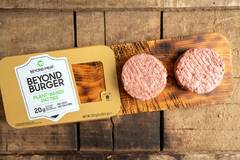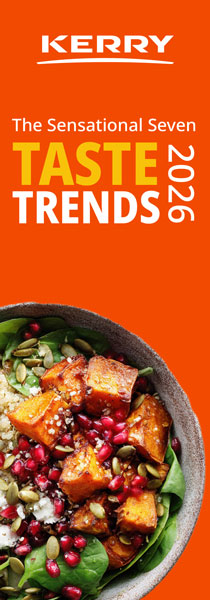Alt-meat and dairy: Innovations move beyond animal-based mimicry amid naturality and hybrid concepts
While alternative meat and dairy products initially started with a sharpened focus on mimicry of conventional meat and dairy products, the trend is now shifting. Consumers are keen to reduce animal-based product consumption and eat more plant proteins, highlighting the “superior nutrition” with higher protein, fewer saturated fats and environmental impact.
But at the center of any NPD, taste is still key. Advancements in cell culture and precision fermentation, clean label demands as well as blending protein sources continue to propel innovation in the field.
Planteneers, ADM, Sensient Flavors & Extracts Europe and IFF chime in on how the alternative meat and dairy landscape has evolved over the years, the latest technologies and what to expect next, in an in-depth discussion with Food Ingredients First.
“The alternative meat and dairy sectors have seen rapid evolution over the past 5-10 years. Initially, the focus was on mimicking the basic structure and appearance of conventional products,” says Dr. Pia Meinlschmidt, team lead Product Management at Planteneers.
“Regarding the ingredients, soy and wheat protein dominated the market. Within the last five years, a wider range of plant proteins like pea, fava bean, chickpea, and blends are being used. However, soy and wheat proteins have gained traction again within the last year due to their functional properties and price.”

 Taste remains the motivation behind purchase intention for alt-meat and dairy products, says Raboanason.Nandrianina Raboanason, marketing manager of Sensient Flavors & Extracts Europe, has also observed a “switch in the way consumers are approaching the plant-based diet.”
Taste remains the motivation behind purchase intention for alt-meat and dairy products, says Raboanason.Nandrianina Raboanason, marketing manager of Sensient Flavors & Extracts Europe, has also observed a “switch in the way consumers are approaching the plant-based diet.”
“Five years ago and more, the idea for many manufacturers was to recreate the same experience meat and dairy are giving with meat and dairy alternatives. The focus was on mimicking the appearance, the taste, the texture of animal-based food, aiming to appeal to omnivores and flexitarians.”
“Today, the focus is expanding beyond mimicry. It is more about reducing the consumption of animal-based products overall by eating more vegetables, pulses or any kind of plant proteins,” she adds.
The top protein ingredients for alt-meat and alt-dairy launches from July 2023 to June 2024 were pea protein (38%), soy protein (17%) and wheat gluten protein (15%), indicates Innova Market Insights data. The category reported a +10% CAGR average annual growth from July 2019 to June 2024.
Push for naturality
Raboanason flags that early plant-based products relied on long lists of ingredients and additives to achieve a meat-like or dairy-like texture and taste. This reliance led to criticisms of these products as being overly processed and lacking a natural quality.
“The push for naturalness and health today is stronger than ever, leading to cleaner label formulation expectations, with fewer and more recognizable ingredients.”
“Part of our range at Sensient Flavors & Extracts is designed for that purpose. From boosters to masking, to specific flavor signatures, our team of flavorists is making sure innovation in ingredient simplification is avoiding the compromise on transparency.”
Dr. Meinlschmidt agrees that there is a shift toward “next-gen plant-based products” that prioritize clean label formulations, enhanced nutrition, and improved taste.
 The industry has shifted towards next-gen plant-based products that prioritize clean label formulations and enhanced nutrition, says Dr. Meinlschmidt.“Consumers today demand products with short ingredient lists, free from methylcellulose, carrageenan and other artificial additives. They also want sustainability — ingredients with a lower environmental footprint, such as fermentation-derived protein and protein sources, which have been minimally processed without chemicals such as hexane.”
The industry has shifted towards next-gen plant-based products that prioritize clean label formulations and enhanced nutrition, says Dr. Meinlschmidt.“Consumers today demand products with short ingredient lists, free from methylcellulose, carrageenan and other artificial additives. They also want sustainability — ingredients with a lower environmental footprint, such as fermentation-derived protein and protein sources, which have been minimally processed without chemicals such as hexane.”
Meat like “bite and chew”
For meat and fish alternatives, Dr. Meinlschmidt believes Texturized Vegetable Proteins provide a meat-like, fibrous structure, along with mycoprotein, which also has a fibrous structure naturally.
Planteneers focuses on fermentation-based ingredients, which offer nutritional value, sustainability benefits, and “superior texture.”
“Besides that, we continue to research new natural texturizing agents that can replicate the bite and chew of meat more accurately.”
Jacquelyn Schuh, global senior director of product marketing, Specialty Ingredients at ADM, agrees that textured plant proteins and extrusion technologies are fundamental to creating the desired “bite and chew” in plant-based meat.
ADM’s AccelFlex Texture Systems (TS) and Functional Systems (FS) leverage soy and pea proteins to address functional, structural and textural components needed to create meat alternative products with “ideal textures and clean label binding solutions.”
“We recently extended this line to include our AccelFlex TS P80, which is a 100% pea protein textured product, helping obtain the expected “bite and chew” of meat-like solutions while boasting a neutral, clean flavor profile and further supporting the development of non-GMO, consumer-preferred meat alternatives without the need for mandatory allergen labeling,” she details.
 Texturized Vegetable Proteins provide a meat-like, fibrous structure in meat and fish substitutes (Image credit: Planteneers).Meanwhile, IFF taps high-moisture extrusion (HME) technology to offer consumers an experience “akin to eating meat” and increased juiciness and muscle-like texture in plant-based meat and seafood products, says Sonia Huppert, innovation marketing leader, Re-Imagine Protein at IFF.
Texturized Vegetable Proteins provide a meat-like, fibrous structure in meat and fish substitutes (Image credit: Planteneers).Meanwhile, IFF taps high-moisture extrusion (HME) technology to offer consumers an experience “akin to eating meat” and increased juiciness and muscle-like texture in plant-based meat and seafood products, says Sonia Huppert, innovation marketing leader, Re-Imagine Protein at IFF.
“Through our internal HME equipment, we are able to integrate this processing into our IFF Product Design approach, combining ingredient and flavor design expertise with advanced industry insights to provide end-to-end product design solutions.”
Using the method, IFF recently developed an optimized chicken flavor for manufacturers, she adds.
“Culinary-forward” approach
Schuh believes alt-meat formulators must take a culinary-forward approach to achieve the desired mouthfeel and juiciness further.
“Our team of chefs, flavorists and formulation experts carefully considers each ingredient in a dish, breaking down the protein type, taste profile, vegetables and herbs to bring food bases, concentrates, spice pastes and marinades to life for mouthwatering cooking cues, flavors and mouthfeel.”
For Raboanason, flavors are essential to bringing juiciness and mouthfeel to meat alternatives, creaminess, dairy notes, or even a napping effect to dairy alternatives.
“A flavor house like Sensient has some real expertise in developing both sweet and savory tailor-made solutions that help mask undesired tastes in products while boosting the overall profile and keeping pleasant lasting.”
“Umami is at the heart of savory products while indulgence and comforting feelings are a staple for sweet and dairy ones.”
Decadent dairy mouthfeel
The interaction of hydrocolloids, starches and plant-based proteins plays a crucial role in achieving the right mouthfeel in dairy alternatives, explains Dr. Meinlschmidt.
 Indulgence and comforting feelings are a staple for sweet and dairy flavors for masking undesired tastes in dairy alternatives.“There are significant quality differences between various sources, and even within the same biological source. By carefully selecting plant-based proteins and considering process parameters such as temperature and pH level, it’s possible to achieve a mouthfeel that resembles that of conventional dairy products.”
Indulgence and comforting feelings are a staple for sweet and dairy flavors for masking undesired tastes in dairy alternatives.“There are significant quality differences between various sources, and even within the same biological source. By carefully selecting plant-based proteins and considering process parameters such as temperature and pH level, it’s possible to achieve a mouthfeel that resembles that of conventional dairy products.”
For ADM’s Schuh, quality plant-based ingredients and texturants are needed to attain the “expected creaminess” of dairy in alternative products.
“Our pea and soy proteins, alongside our texturants, emulsifiers and plant-based fats and oils, ensure a consistent, smooth and decadent mouthfeel is developed. Our Stabrium Hydrocolloid Solutions are designed to add rich body and thickness to plant-based yogurts, beverages and frozen treats.”
Tackling plant-protein challenges
Plant proteins tend to bind with flavor and taste compounds, which may create undesirable earthy or beany notes, flags Schuh. However, starting with quality, clean-tasting plant proteins and flavor masking technologies can mitigate these concerns.
“Our TasteSpark flavor masking technology neutralizes any unwanted off-notes and elevates desired flavor profiles. Through an extensive portfolio of vegan-suitable flavors, we ensure these alternative applications shine. This includes milk-, cream-, butter- and a multitude of cheese-type flavors, along with beef-, chicken-, salmon- and white fish-type flavors, and more.”
Meanwhile, fats and oils used in plant-based products can also impart flavors that may not be desirable in certain formulations, notes Dr. Meinlschmidt. Planteneers addresses these challenges by combining balanced protein blends, flavor-masking agents, advanced fermentation techniques and natural sweeteners or acids.
 ADM’s new Pork Platform of Excellence pushes the boundaries of pork-type flavor profiles for innovative plant-based pork alternative developments, says Schuh.“By optimizing the protein blend, for example, we can reduce the intensity of undesirable flavors while improving the texture and mouthfeel. In addition, natural flavor modifiers block or neutralize undesirable flavors without compromising the product’s appeal.”
ADM’s new Pork Platform of Excellence pushes the boundaries of pork-type flavor profiles for innovative plant-based pork alternative developments, says Schuh.“By optimizing the protein blend, for example, we can reduce the intensity of undesirable flavors while improving the texture and mouthfeel. In addition, natural flavor modifiers block or neutralize undesirable flavors without compromising the product’s appeal.”
Unlocking hybrid power
The alt-protein industry is also exploring blended protein solutions or hybrids to leverage the best characteristics from different protein sources for optimized sensory appeal, along with protein quality, content and diversity, states Schuh.
ADM combines its soy, pea, wheat proteins, beans and pulses to create a “delectable blend of consumer-preferred ingredients” for alternative meat and dairy formulations.
“Our plant-based ingredients also support blended options with animal-based proteins, which can help introduce consumers to alternative options and deliver on the gold-standard taste of traditional meat and dairy offerings without asking consumers to radically change their diets and lifestyles.”
Meanwhile, Dr. Meinlschmidt believes blending plant-based and cell-cultured ingredients provides superior taste and texture while leveraging sustainability claims and Raboanason observes a rise in hybrid product launches.
Raboanason also sheds light on how regulations have a role to play in plant-based alternative advancements.
“Regulatory frameworks for plant-based products were not well defined in the past, with some pushback on labeling plant-based items as “milk,” “cheese” or “meat.” Now there’s more scrutiny over it, with some regions implementing or proposing laws restricting the use of certain wordings when it comes to plant-based alternatives.”
“This is important to consider for manufacturers as the product positioning will need to follow the rules, but it also leaves the doors open for creative marketing and product promotion.”
Opening up opportunities
Companies previously focused mainly on plant-based products with little exploration of other technologies due to technological and regulatory hurdles, Raboanason adds. But the landscape has now changed.
 Brands must strike a balance between familiarity and innovation while ensuring that their plant-based products are delicious, says Huppert.“Today, precision fermentation and cell-cultured meat are at the forefront of innovation. These technologies offer more sustainable and supposedly ethical solutions addressing land and water use concerns in traditional farming.”
Brands must strike a balance between familiarity and innovation while ensuring that their plant-based products are delicious, says Huppert.“Today, precision fermentation and cell-cultured meat are at the forefront of innovation. These technologies offer more sustainable and supposedly ethical solutions addressing land and water use concerns in traditional farming.”
“But these products are still in the early stages of commercialization, hence representing a hope for the future in alternative meat and dairy NPDs.”
Dr. Meinlschmidt highlights major trends toward sustainably produced proteins as customers increasingly demand minimally processed proteins.
“With this in mind, we are currently expanding our range. We are working on new formulations using fermentation-derived ingredients that enhance both nutrition and texture.”
“In addition to mycoprotein, the focus is on microalgae, which not only add flavor but also have a positive effect on texture and nutritional value,” she concludes.














